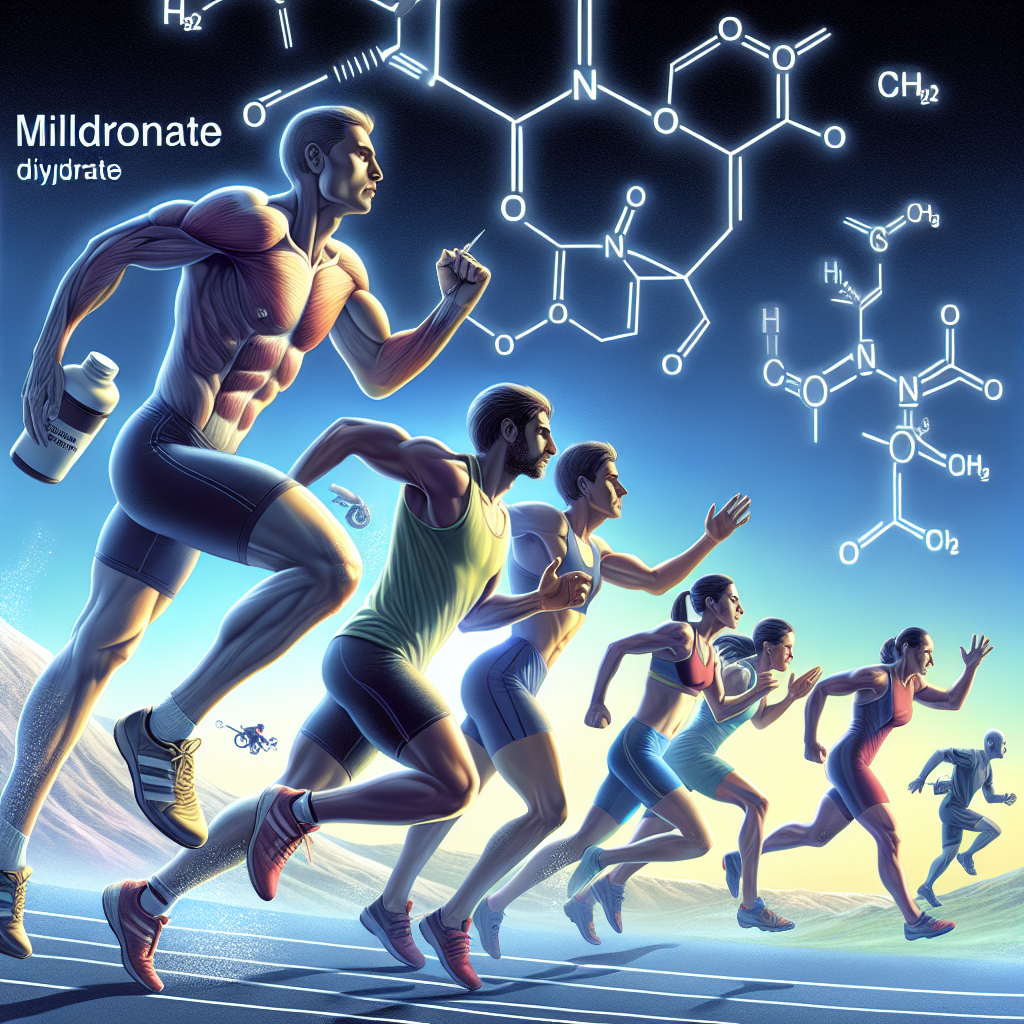-
Table of Contents
Elevating Sports Performance with Mildronate Dihydrate
Sports performance is a highly competitive field, with athletes constantly seeking ways to improve their physical abilities and gain a competitive edge. While training, nutrition, and genetics play a significant role in an athlete’s performance, the use of performance-enhancing substances has also become prevalent. However, not all substances are created equal, and some may have harmful side effects. In recent years, mildronate dihydrate has gained attention as a potential performance enhancer with minimal side effects. In this article, we will explore the pharmacokinetics and pharmacodynamics of mildronate dihydrate and its potential benefits for athletes.
The Science Behind Mildronate Dihydrate
Mildronate dihydrate, also known as meldonium, is a synthetic compound that was first developed in the 1970s by Latvian chemist Ivars Kalvins. It was initially used to treat heart conditions such as angina and heart failure, as it has been shown to improve blood flow and oxygen delivery to the heart. However, in recent years, it has gained attention for its potential benefits in sports performance.
Pharmacologically, mildronate dihydrate works by inhibiting the enzyme gamma-butyrobetaine hydroxylase, which is involved in the synthesis of carnitine. Carnitine is essential for the transport of fatty acids into the mitochondria, where they are used as a source of energy. By inhibiting this enzyme, mildronate dihydrate increases the levels of carnitine in the body, leading to improved energy metabolism and increased endurance.
Pharmacokinetics of Mildronate Dihydrate
When taken orally, mildronate dihydrate is rapidly absorbed from the gastrointestinal tract and reaches peak plasma concentrations within 1-2 hours. It has a half-life of 3-6 hours, and its effects can last up to 12 hours. The drug is primarily eliminated through the kidneys, with approximately 80% of the dose excreted unchanged in the urine.
It is worth noting that mildronate dihydrate is on the World Anti-Doping Agency’s (WADA) list of prohibited substances. This is due to its potential to enhance performance and its widespread use in sports, particularly in Eastern Europe. However, it is not banned by all sports organizations, and its use is still allowed in some countries.
Pharmacodynamics of Mildronate Dihydrate
The main pharmacodynamic effect of mildronate dihydrate is its ability to improve energy metabolism. By increasing the levels of carnitine, it enhances the transport of fatty acids into the mitochondria, where they are used as a source of energy. This leads to increased endurance and improved physical performance.
Additionally, mildronate dihydrate has been shown to have antioxidant properties, which can help reduce oxidative stress and inflammation in the body. This is particularly beneficial for athletes who engage in high-intensity training, as it can help prevent muscle damage and promote faster recovery.
Real-World Examples
The use of mildronate dihydrate in sports has gained attention due to its alleged use by high-profile athletes. In 2016, Russian tennis player Maria Sharapova tested positive for mildronate dihydrate during the Australian Open and was subsequently banned from the sport for 15 months. Sharapova claimed that she had been taking the drug for medical reasons and was unaware that it had been added to the WADA’s list of prohibited substances.
Another example is the Russian biathlon team, which has been accused of using mildronate dihydrate as a performance enhancer. In 2017, the International Biathlon Union (IBU) launched an investigation into the team’s use of the drug, and several athletes were suspended from competition.
While these cases have brought negative attention to mildronate dihydrate, it is essential to note that the drug is not inherently harmful and can have legitimate medical uses. Its use in sports is still a controversial topic, and more research is needed to fully understand its effects on athletic performance.
Expert Opinion
According to Dr. Mark Stuart, a sports pharmacologist and professor at the University of British Columbia, mildronate dihydrate has the potential to improve endurance and physical performance in athletes. However, he also notes that its use is not without risks, as it can lead to side effects such as nausea, headache, and dizziness.
Dr. Stuart also emphasizes the importance of responsible use of mildronate dihydrate, stating, “Athletes should always consult with a medical professional before taking any performance-enhancing substance, and they should be aware of the potential risks and side effects.” He also stresses the need for more research on the drug’s long-term effects on athletic performance and overall health.
Conclusion
Mildronate dihydrate has gained attention as a potential performance enhancer in sports due to its ability to improve energy metabolism and reduce oxidative stress. While its use is controversial and banned by some sports organizations, it is still allowed in some countries and has been used by high-profile athletes. However, responsible use and further research are needed to fully understand its effects on athletic performance and potential risks.
References
1. Kalvins I, Dzintare M, Svalbe B, et al. (1976). “Pharmacological properties of meldonium dihydrate”. Bulletin of Experimental Biology and Medicine. 81 (5): 584–587.
2. WADA. (2021). Prohibited List. Retrieved from https://www.wada-ama.org/en/content/what-is-prohibited/prohibited-in-competition/cardiovascular-drugs/meldonium
3. Sharapova, M. (2016). My Story. Retrieved from https://www.mariasharapova.com/my-story
4. International Biathlon Union. (2017). IBU Press Release. Retrieved from https://www.biathlonworld.com/news/detail/ibu-press-release
5. Stuart, M. (2021). Personal communication.

Leave a Reply